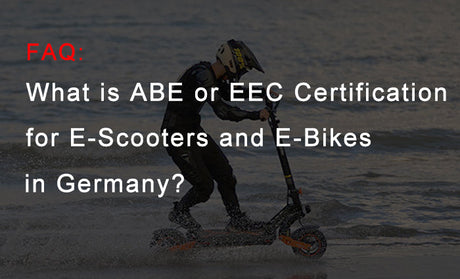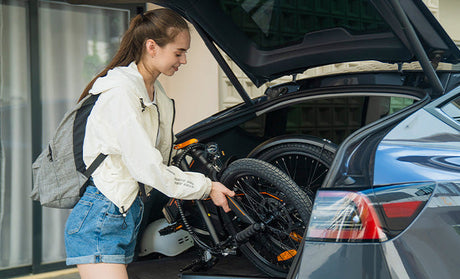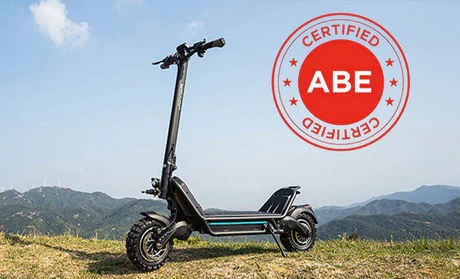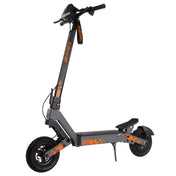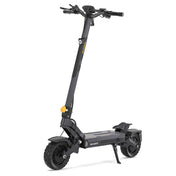Die Wahl des richtigen Verkehrsmittels kann Ihren Alltag, Ihr Pendelerlebnis und sogar Ihre Gesundheit erheblich beeinflussen. Da Elektroroller und Fahrräder immer beliebter werden, ist es für eine fundierte Entscheidung unerlässlich, die Unterschiede zwischen beiden zu verstehen. Dieser Artikel bietet einen detaillierten Vergleich von Elektrorollern und Fahrrädern und behandelt dabei unter anderem Kosten, Benutzerfreundlichkeit und Umweltauswirkungen.

Inhalt
- Vergleichsübersicht
-
Kosten und Erschwinglichkeit
1. Anschaffungspreis
2. Wartungskosten
3. Langfristige Investition -
Benutzerfreundlichkeit
1. Lernkurve für Anfänger
2. Manövrierfähigkeit und Manövrierfähigkeit
3. Speicherung und Portabilität -
Geschwindigkeit und zurückgelegte Strecke
1. Vergleich der Durchschnittsgeschwindigkeit
2. Zurückgelegte Strecke pro Ladung oder Fahrt
3. Faktoren, die Geschwindigkeit und zurückgelegte Strecke beeinflussen -
Umweltauswirkungen
1. Emissionen und Nachhaltigkeit
2. Energieverbrauch
3. Lebensdauer und Recyclingfähigkeit -
Gesundheitliche Vorteile
1. Sorgt für körperliche Aktivität
2. Herz-Kreislauf-Vorteile
3. Vorteile für die psychische Gesundheit -
Sicherheitsaspekte
1. Unfall- und Verletzungsgefahr
2. Erforderliche Schutzausrüstung
3. Verkehrssicherheitsvorschriften -
Komfort und Zugänglichkeit
1. Verfügbarkeit von Ladestationen
2. Park- und Lagermöglichkeiten
3. Geeignet für verschiedene Altersgruppen -
Anpassungsfähigkeit an Wetter und Gelände
1. Leistung bei verschiedenen Wetterbedingungen
2. Geeignet für verschiedene Gelände
3. Haltbarkeit und Robustheit -
Wartung und Reparaturen
1. Häufigkeit und Komplexität der Wartung
2. Verfügbarkeit von Reparaturdiensten
3. Häufige Probleme und Reparaturen -
Gesetze und Vorschriften
1. Alters- und Führerscheinvoraussetzungen
2. Geschwindigkeitsbegrenzungen und Straßennutzung
3. Lokale Vorschriften und Einschränkungen -
Technische Eigenschaften
1. Erweiterte Funktionen und Gadgets
2. App-Integration und Konnektivität
3. Zukünftige Trends und Innovationen -
Speicher und Portabilität
1. Faltbare und kompakte Designs
2. Aufbewahrungslösungen für Zuhause und den Arbeitsplatz
3. Öffentliche Verkehrsmittel -
Benutzereinstellungen und Szenarien
1. Pendeln von der Arbeit oder Schule
2. Freizeit- und Erholungsnutzungen
3. Spezifische Benutzerszenarien und Bedürfnisse - Abschluss
- Häufig gestellte Fragen
Vergleichsübersicht
| Aspekt | Elektroroller | Fahrräder |
|---|---|---|
| Anfänglicher Kaufpreis | 300 bis 2.000 US-Dollar | 300 bis 1.000 US-Dollar |
| Instandhaltungskosten | Höher | Untere |
| Langfristige Investition | Häufiger Austausch | Langlebigkeit bei richtiger Pflege |
| Lernkurve | Einfacher | Erfordert mehr Geschick |
| Handhabung und Manövrierfähigkeit | Gut | Exzellent |
| Speicher und Portabilität | Kompakt und faltbar | Größer, aber Fahrradständer vorhanden |
| Durchschnittsgeschwindigkeit | 15 bis 25 Meilen pro Stunde (45 Meilen pro Stunde) | 10 bis 20 Meilen pro Stunde |
| Reichweite pro Ladung/Fahrt | 15 bis 40 Meilen | Oft über 50 Meilen |
| Emissionen | Minimal | Null |
| Energieverbrauch | Niedrig | Keiner |
| Lebensdauer und Recyclingfähigkeit | Kürzer, schwieriger zu recyceln | Länger und einfacher zu recyceln |
| Körperliche Betätigung | Minimal | Ganzkörpertraining |
| Herz-Kreislauf-Vorteile | Minimal | Bedeutsam |
| Vorteile für die psychische Gesundheit | Stressabbau | Verbessert die Stimmung und das Wohlbefinden |
| Unfallrisiko | Mäßig | Mäßig |
| Schutzausrüstung | Helme, Handgelenkschützer | Helme, Schoner |
| Verkehrssicherheitsvorschriften | Variiert je nach Standort | Variiert je nach Standort |
| Ladeanforderungen | Muss aufgeladen werden | Keiner |
| Parken und Lagerung | Einfach im Innenbereich | Benötigt Fahrradständer |
| Zugänglichkeit | Verstellbarer Lenker | Geeignet für alle Altersgruppen |
| Wetteranpassungsfähigkeit | Weniger anpassungsfähig | Anpassungsfähiger |
| Geländeeignung | Glatte Oberflächen | Verschiedene Gelände |
| Haltbarkeit | Empfindliche Elektronik | Stabile Rahmen |
| Wartungshäufigkeit | Weniger häufig | Regelmäßige Wartung |
| Reparaturservice | Spezialisiert | Weit verbreitet |
| Häufige Probleme | Batterie, Elektronik | Platte Reifen, Ketten |
| Gesetzliche Bestimmungen | Alters- und Führerscheinanforderungen | Generell weniger Einschränkungen |
| Geschwindigkeitsbegrenzungen | Oft eingeschränkt | Generell weniger Einschränkungen |
| Gemeinschaftliche und soziale Nutzung | Neue Gemeinschaften | Etablierte Gemeinschaften |
| Freizeitvergnügen | Spaß und Mühelosigkeit | Körperliche Betätigung |
| Technologische Merkmale | Fortschrittliche Gadgets | GPS, Fitness-Monitore |
| App-Integration | Gemeinsam | Gemeinsam |
| Zukünftige Innovationen | Batterietechnologie, Konnektivität | Materialien, Leistungsverbesserungen |
| Faltbare Designs | Oft faltbar | Einige Klappmodelle |
| Öffentliche Verkehrsmittel | Einfacher zu transportieren | Variiert je nach Region |
| Pendeln | Komfortabel | Bewegung und Vielseitigkeit |
| Freizeitnutzung | Unterhaltsame Erkundung | Körperliche Betätigung |
| Spezifische Bedürfnisse | Eingeschränkte Mobilität | Fitnessbegeisterte |
Kosten und Erschwinglichkeit
Anfänglicher Kaufpreis
Im Vergleich zu Fahrrädern sind Elektroroller in der Regel teurer. Während hochwertige Fahrräder zwischen 300 und 1.000 Euro kosten, kosten Elektroroller je nach Ausstattung und Marke typischerweise zwischen 500 und 2.000 Euro. Natürlich gibt es auch günstigere Elektroroller unter 500 Euro, wie zum Beispiel die E-Scooter von JOYOR , die legal und ohne Führerschein gefahren werden können.
Instandhaltungskosten
Da Fahrräder über einfachere mechanische Systeme verfügen, sind die Wartungskosten im Allgemeinen geringer. Regelmäßige Wartungsarbeiten, wie Reifenwechsel und Bremseneinstellung, sind relativ günstig. Bei Elektrorollern hingegen können teurere Reparaturen erforderlich sein, insbesondere Batteriewechsel und Reparaturen elektronischer Komponenten.
Langfristige Investition
Bei einer langfristigen Investition haben beide Optionen ihre Vor- und Nachteile. Bei richtiger Wartung können Fahrräder viele Jahre halten, während bei Elektrorollern ein häufigerer Austausch von Batterien und elektronischen Teilen erforderlich sein kann. Allerdings können Elektroroller Transportkosten sparen, da sie Autofahrten oder Fahrten mit öffentlichen Verkehrsmitteln ersetzen.

Benutzerfreundlichkeit
Lernkurve für Anfänger
Fahrräder erfordern ein gewisses Maß an Geschick und Gleichgewicht, insbesondere für Anfänger. Das Erlernen des Fahrradfahrens kann einige Zeit und Übung erfordern. Elektroroller sind jedoch im Allgemeinen einfacher zu beherrschen, und die meisten Menschen können nach kurzer Übung bequem fahren.
Manövrierfähigkeit und Manövrierfähigkeit
Fahrräder sind besonders in dicht besiedelten Stadtgebieten sehr wendig. Sie können problemlos durch Verkehr und enge Räume navigieren. Elektroroller sind ebenfalls sehr wendig, können aber aufgrund ihrer kleineren Räder und der Standposition auf unebenem Untergrund im Vergleich zu Fahrrädern weniger stabil sein. Natürlich ist die Reifengröße von Elektrorollern auf unterschiedliche Untergründe abgestimmt. Lesen Sie den verwandten Artikel: Vergleich verschiedener Reifengrößen für Elektroroller
Lagerung und Portabilität
Elektroroller haben den Vorteil, kompakter und mobiler zu sein. Viele Modelle sind faltbar, sodass sie leicht zu transportieren und auf kleinem Raum zu verstauen sind. Sie können auch im Kofferraum verstaut oder in der U-Bahn mitgenommen werden. Fahrräder sind zwar größer, können aber in einem Fahrradständer verstaut werden und sind in der Regel einfacher mit einem Schloss zu sichern.

Geschwindigkeit und zurückgelegte Strecke
Vergleich der Durchschnittsgeschwindigkeit
Elektroroller sind im Allgemeinen schneller als Fahrräder und erreichen Durchschnittsgeschwindigkeiten zwischen 24 und 40 km/h. Leistungsstärkere E-Scooter können jedoch höhere und schnellere Geschwindigkeiten von bis zu 72 km/h erreichen. Fahrräder erreichen typischerweise Geschwindigkeiten zwischen 16 und 32 km/h, abhängig von der Fitness des Fahrers und dem Gelände.
Zurückgelegte Strecke pro Ladung oder Fahrt
Elektroroller haben eine begrenzte Reichweite pro Ladung, typischerweise zwischen 24 und 64 Kilometern, je nach Modell und Batteriekapazität. Fahrräder werden durch Muskelkraft angetrieben und können größere Entfernungen zurücklegen. Je nach Kraft und Ausdauer des Benutzers können die Fahrer typischerweise 80 Kilometer oder mehr pro Tag zurücklegen.
Faktoren, die Geschwindigkeit und zurückgelegte Strecke beeinflussen
Sowohl Elektroroller als auch Fahrräder werden von Faktoren wie Gelände, Wetter und Fahrergewicht beeinflusst. Hügel und unebene Oberflächen verringern Geschwindigkeit und zurückgelegte Strecke, während glatte, ebene Oberflächen die Leistung verbessern.

Umweltauswirkungen
Emissionen und Nachhaltigkeit
Sowohl Elektroroller als auch Fahrräder sind im Vergleich zu Autos umweltfreundliche Alternativen. Fahrräder sind auf menschliche Kraft angewiesen und verursachen daher keine Emissionen. Elektroroller verursachen nur minimale Emissionen, vor allem bei der Herstellung und beim Laden, sind aber dennoch eine nachhaltigere Alternative als benzinbetriebene Autos.
Energieverbrauch
In Bezug auf den Energieverbrauch sind Fahrräder die klaren Gewinner, da sie keine externe Stromquelle benötigen. Elektroroller verbrauchen zwar Strom, der Energieverbrauch ist jedoch relativ gering, insbesondere im Vergleich zu Autos oder Motorrädern.
Lebensdauer und Recyclingfähigkeit
Fahrräder haben im Allgemeinen eine längere Lebensdauer und lassen sich am Ende ihrer Nutzungsdauer leichter recyceln. Elektroroller mit ihren Batterien und elektronischen Komponenten stellen eine größere Herausforderung für das Recycling dar, verbessern sich aber in dieser Hinsicht mit dem technologischen Fortschritt allmählich.

Gesundheitliche Vorteile
Bietet körperliche Aktivität
Fahrräder bieten erhebliche gesundheitliche Vorteile, da sie ein Ganzkörpertraining ermöglichen, die Herz-Kreislauf-Gesundheit verbessern und Muskelkraft aufbauen. E-Scooter erfordern weniger körperliche Aktivität, da sie kein Treten erfordern und hauptsächlich den Unterkörper für Gleichgewicht und Kontrolle trainieren.
Herz-Kreislauf-Vorteile
Regelmäßiges Radfahren verbessert nachweislich die Herz-Kreislauf-Gesundheit, senkt das Risiko von Herzerkrankungen und erhöht die allgemeine Ausdauer. Die kardiovaskulären Vorteile des Fahrens eines E-Scooters sind im Vergleich zum Fahrradfahren minimal.
Vorteile für die psychische Gesundheit
Beide Fortbewegungsmittel können die psychische Gesundheit verbessern, indem sie Stress reduzieren und ein Gefühl von Freiheit fördern. Insbesondere Radfahren kann durch körperliche Aktivität und Zeit im Freien die Stimmung und die psychische Gesundheit verbessern.

Sicherheitsaspekte
Unfall- und Verletzungsgefahr
Sowohl E-Scooter als auch Fahrräder bergen ein Unfall- und Verletzungsrisiko, insbesondere im geschäftigen Stadtverkehr. Die richtige Sicherheitsausrüstung wie Helme und reflektierende Kleidung ist für beide unerlässlich.
Lesen Sie verwandte Artikel zum Thema sicheres Fahren:
Sicherheitsvorkehrungen beim Fahren eines Elektrofahrrads: Ein Muss für Anfänger?
Was sagt uns Gordon Ramsays Fahrradunfall?
Erforderliche Schutzausrüstung
Helme sind sowohl für E-Scooter- als auch für Fahrradfahrer unverzichtbar, um Kopfverletzungen vorzubeugen. Zusätzlich benötigen Fahrradfahrer möglicherweise Knie- und Ellbogenschützer , während E-Scooter-Fahrer Handgelenkschützer für zusätzlichen Schutz in Betracht ziehen sollten.
Verkehrssicherheitsvorschriften
Für E-Scooter und Fahrräder gelten örtlich unterschiedliche Verkehrssicherheitsvorschriften. Fahrer sollten sich mit den örtlichen Gesetzen wie Helmpflicht, Geschwindigkeitsbegrenzungen und ausgewiesenen Fahrbereichen vertraut machen.

Komfort und Zugänglichkeit
Verfügbarkeit von Ladestationen
E-Scooter müssen aufgeladen werden, was eine Einschränkung darstellen kann, wenn Ladestationen nicht in der Nähe sind. Viele Fahrer laden ihre Roller jedoch zu Hause oder am Arbeitsplatz auf. Fahrräder haben diese Einschränkung nicht, da sie keine externe Stromquelle benötigen.
Park- und Lagermöglichkeiten
In städtischen Umgebungen gibt es für Fahrräder oft eigene Abstellplätze und Ständer, während E-Scooter zusammengeklappt und einfacher in Innenräumen verstaut werden können. Beide Optionen erfordern sichere Schließmechanismen, um Diebstahl zu verhindern.
Geeignet für verschiedene Altersgruppen
Fahrräder und E-Scooter sind für Menschen jeden Alters geeignet. Fahrräder mit kleineren Rahmen und niedrigeren Gängen eignen sich für Kinder, während E-Scooter mit verstellbarem Lenker für Menschen jeder Größe und jedes Alters geeignet sind.

Anpassungsfähigkeit an Wetter und Gelände
Leistung bei verschiedenen Wetterbedingungen
Sowohl Fahrräder als auch E-Scooter können von den Wetterbedingungen beeinflusst werden. Regen und Schnee können das Fahren rutschig und gefährlich machen. E-Scooter haben kleinere Räder und können bei schlechtem Wetter größere Probleme haben als Fahrräder.

Geeignet für verschiedene Gelände
Fahrräder sind im Allgemeinen vielseitiger und können mit unterschiedlichem Gelände umgehen, einschließlich Offroad-Strecken. Elektroroller eignen sich am besten für glatte, gepflasterte Oberflächen und funktionieren auf rauen oder unebenen Oberflächen möglicherweise nicht so gut.
Haltbarkeit und Robustheit
Fahrräder sind im Allgemeinen langlebiger und robuster und verfügen über stabile Rahmen, die unterschiedlichen Bedingungen standhalten. Elektroroller sind zwar langlebig, verfügen jedoch möglicherweise über empfindlichere elektronische Komponenten, die eine sorgfältige Handhabung erfordern.
Lesen Sie den zugehörigen Artikel: Wartungstipps für Elektroroller

Wartung und Reparaturen
Häufigkeit und Komplexität der Wartung
Fahrräder erfordern regelmäßige Wartung, wie z. B. Kettenschmierung, Reifendruck und Bremseinstellung. Diese sind relativ einfach und können in der Regel zu Hause durchgeführt werden. E-Scooter erfordern möglicherweise eine speziellere Wartung der Batterie und des elektronischen Systems.
Verfügbarkeit von Reparaturdiensten
Fahrradreparaturdienste sind weit verbreitet und in der Regel erschwinglich. E-Scooter benötigen möglicherweise spezialisierte Reparaturdienste, die teurer und schwieriger zu finden sein können. Für OOLACTIVE E-Bike- und E-Scooter-Shops bieten wir jedoch Garantien sowohl auf E-Bikes als auch auf E-Scooter an und ersetzen das Produkt oder Zubehör bei Bedarf. Der Kundendienst ist sehr schnell.
Häufige Probleme und Reparaturen
Zu den häufigsten Fahrradproblemen gehören platte Reifen und Kettenprobleme, die sich in der Regel leicht beheben lassen. Bei E-Scootern können Probleme mit der Batterie, dem Motor und der Elektronik auftreten, deren Diagnose und Reparatur komplizierter sein kann.

Gesetze und Vorschriften
Alters- und Führerscheinanforderungen
Gesetze und Vorschriften für E-Scooter und Fahrräder variieren von Region zu Region. In manchen Gebieten gelten Altersbeschränkungen und möglicherweise ist ein E-Scooter-Führerschein erforderlich. Für Fahrräder gelten solche Anforderungen im Allgemeinen nicht.
Geschwindigkeitsbegrenzungen und Straßennutzung
Für E-Scooter gelten in der Regel Geschwindigkeitsbegrenzungen und das Befahren bestimmter Straßen und Radwege kann verboten sein. Fahrräder können Straßen, Radwege und Radwege im Allgemeinen freier nutzen.
Lokale Vorschriften und Einschränkungen
Die örtlichen Vorschriften können sehr unterschiedlich sein, und manche Städte haben spezielle Regeln für E-Scooter, wie z. B. ausgewiesene Parkplätze und Sperrgebiete. Auch Radfahrer müssen die örtlichen Verkehrsregeln einhalten.

Technische Eigenschaften
Erweiterte Funktionen und Gadgets
Elektroroller sind oft mit erweiterten Funktionen wie LED-Leuchten , digitalen Anzeigen und App-Konnektivität ausgestattet. Fahrräder können auch mit Geräten wie GPS-Trackern , intelligenten Schlössern und Fitnessmonitoren ausgestattet sein.
App-Integration und Konnektivität
Viele Elektroroller verfügen über eine App-Integration, mit der Fahrer ihre Fahrten verfolgen, den Akkustand überwachen und Einstellungen anpassen können. Fahrräder können auch Apps zur Routenplanung, zum Fitness-Tracking und zur Nutzung sozialer Netzwerke nutzen.
Zukünftige Trends und Innovationen
Die Zukunft sieht sowohl für Elektroroller als auch für Elektrofahrräder rosig aus. Ständige Innovationen zielen auf mehr Leistung, Sicherheit und Komfort ab. Fortschritte in Batterietechnologie, Materialien und Konnektivität werden beide Fortbewegungsmittel weiter verbessern. Und jetzt gibt es Elektrofahrräder, die es einfacher und schneller machen, ans Ziel zu gelangen.

Speicher und Portabilität
Faltbare und kompakte Designs
Elektroroller sind oft faltbar und kompakt, was den Transport und die Lagerung erleichtert. Manche Fahrräder sind ebenfalls faltbar, aber sie sind in der Regel sperriger als Roller.
Aufbewahrungslösungen für Zuhause und den Arbeitsplatz
Sowohl Elektroroller als auch Fahrräder benötigen sichere Aufbewahrungslösungen. Aufgrund ihrer kompakten Größe können Roller in Innenräumen gelagert werden, während Fahrräder möglicherweise einen speziellen Fahrradständer oder einen sicheren Abstellbereich benötigen.
Öffentliche Verkehrsmittel
E-Scooter lassen sich aufgrund ihrer kompakten Größe und Faltbarkeit oft leichter in öffentlichen Verkehrsmitteln transportieren. Auch Fahrräder können in öffentlichen Verkehrsmitteln mitgenommen werden, allerdings können Platz und Einschränkungen je nach Region variieren.

Benutzereinstellungen und Szenarien
Pendeln zur Arbeit oder Schule
Für den Arbeitsweg hängt die Wahl zwischen einem E-Scooter und einem Fahrrad von Faktoren wie Entfernung, Gelände und persönlichen Vorlieben ab. E-Scooter bieten eine bequeme und schweißfreie Alternative, während Fahrräder Bewegung und Vielseitigkeit bieten.
Freizeit- und Erholungszwecke
Sowohl E-Scooter als auch Fahrräder eignen sich gut für die Freizeitgestaltung. Fahrräder bieten den zusätzlichen Vorteil körperlicher Bewegung, während E-Scooter eine unterhaltsame und einfache Möglichkeit bieten, neue Gebiete zu erkunden.
Spezifische Benutzerszenarien und Bedürfnisse
Verschiedene Nutzer haben möglicherweise spezifische Bedürfnisse, die eine Option geeigneter machen als eine andere. Beispielsweise kann jemand mit eingeschränkter Mobilität den Komfort eines E-Scooters bevorzugen, während ein Fitnessbegeisterter die körperlichen Vorteile des Radfahrens bevorzugt.

Abschluss
Zusammenfassend lässt sich sagen, dass sowohl Elektroroller als auch Fahrräder ihre individuellen Vorteile haben und sich für unterschiedliche Zwecke eignen. Elektroroller sind praktisch, einfach zu bedienen und ideal für kurze Fahrten, während Fahrräder erhebliche gesundheitliche Vorteile, Vielseitigkeit und ein starkes Gemeinschaftsgefühl bieten. Letztendlich hängt die Wahl zwischen einem Elektroroller und einem Fahrrad von Ihren persönlichen Vorlieben, Ihrem Lebensstil und Ihren spezifischen Bedürfnissen ab.
FAQs
Was ist kostengünstiger, ein Elektroroller oder ein Fahrrad?
Aufgrund der geringeren Anschaffungs- und Wartungskosten sind Fahrräder im Allgemeinen kostengünstiger.
Sind Elektroroller schneller als Fahrräder?
Elektroroller bieten im Vergleich zu Fahrrädern normalerweise höhere Geschwindigkeiten zwischen 24 und 40 km/h.
Welche Option ist besser für die Umwelt?
Beide sind umweltfreundlich, aber Fahrräder verursachen keine Emissionen und benötigen keine externen Stromquellen.
Benötigt man für E-Scooter einen Führerschein?
Die Lizenzanforderungen variieren je nach Region. In manchen Gebieten ist für Elektroroller eine Lizenz erforderlich.
Kann ich einen Elektroroller bei Regen benutzen?
Die Nutzung von Elektrorollern bei leichtem Regen ist möglich, aufgrund der rutschigen Oberflächen und möglicher Wasserschäden an elektronischen Komponenten ist jedoch Vorsicht geboten.






